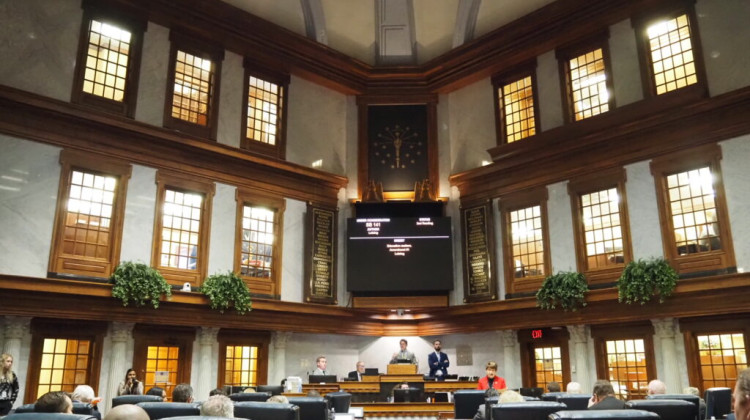
Several right- and left-leaning think tanks, as well as academic researchers, have put out analyses on the impacts of prevailing wage rules (or the lack thereof). They often come to contradictory or inconclusive conclusions.
ITB495/FlickrIndiana has billions of federal dollars coming to fund infrastructure projects, like increased capacity on northeast Indiana’s South Shore train line and additional lanes on Interstate 465 in central Indiana. Because they’re partly funded by federal dollars, these projects are subject to federal prevailing wage rules.
“Common” or “prevailing” construction wages in state and federal law set minimum amounts construction workers must be paid on large government-funded projects based on the project area’s local economy and other factors. The prevailing wage is set differently for each type of construction worker classification needed for the project.
U.S. Department of Labor officials just announced an overhaul that aims to bolster wages on federal projects for years to come.
Indiana got rid of its common construction wage law back in 2015. But the repeal doesn’t prevent the rules from being applied to federally funded projects in the state.
Proponents of the prevailing wage include worker advocacy and union groups like the AFL-CIO and the Indiana State Building & Construction Trades Council.
They say use of the prevailing wage ensures fairer pay across the industry, stimulates local economies by helping more local workers get jobs and secures safer, higher-quality work on taxpayer-funded projects.
Opponents of the prevailing wage include industry groups like the Indiana Chamber of Commerce and the Associated Builders and Contractors Inc.
They argue such rules over-inflate the cost of construction projects to taxpayers and unfairly favor union-affiliated and non-local construction contractors, as they tend to pay more.
Those criticisms were behind Indiana's 2015 repeal of its common construction wage. The repeal also prohibited local governments from setting their own common wage rules for projects they fund as municipalities like South Bend city leaders said they had planned to do at the time.
A 2021 report by Indiana’s Department of Labor concluded the repeal had “no significant impact” on wages, employment levels or the cost of public construction projects. It attributed drops and increases in these areas over the years before and after the repeal to normal fluctuations for the industry. Though the report also said outcomes were hard to measure due to a lack of strong data.
Several right- and left-leaning think tanks, as well as academic researchers, have put out analyses on the impacts of prevailing wage rules (or the lack thereof). They often come to contradictory or inconclusive conclusions.
The changes to the existing federal prevailing wage model announced Tuesday will likely result in a higher minimum for many workers across the country, according to the U.S. DOL. The changes are some of the most significant updates to the formula in the last 40 years.
Join the conversation and sign up for the Indiana Two-Way. Text "Indiana" to 73224. Your comments and questions in response to our weekly text help us find the answers you need on statewide issues.
A federal project’s prevailing wage is set primarily by a survey of construction wages in the project's area. That's where the DOL’s biggest and most controversial change in this new rule comes in. The prevailing wage gets set based on the wages reported by at least 50 percent of workers surveyed in the area.
In about one-third of projects since 2015, that’s all officials had to do to determine the wage for a specific job classification. However, officials often aren't able to find a wage equally shared across that simple majority. In those cases, they use a different measurement: an average of wages for the specific job classification.
The problem with that, according to the U.S. Department of Labor, is that relying on such averages “allows a single low-wage contractor in the area to depress wage rates on federal contracts below the higher rate that may be generally more prevalent” in the project area.
The new rule still allows the wage rate to be set based on an average – but only as a “last resort.” Under the new rule, if there is no wage shared across 50 percent of area workers in a specific construction job classification, officials must first try to find a wage shared by at least 30 percent of those workers instead.
They are allowed to fall back on averages only if they fail to find a wage rate meeting that 30 percent threshold.
The DOL estimates that this change, which is actually a return to the way prevailing wages were calculated pre-1983, will result in averages only being used in about 30 percent of federal projects. It is currently being used twice as often.
The department estimates the 50 percent and 30 percent thresholds will be used in about two-thirds of all federal projects. DOL officials justified this change and others in a lengthy document that responds directly to criticisms made during the rule’s public comment period.
Adam is our labor and employment reporter. Contact him at arayes@wvpe.org or follow him on Twitter at @arayesIPB.
9(MDAyMzk1MzA4MDE2MjY3OTY1MjM5ZDJjYQ000))
 DONATE
DONATE






 Support WFYI. We can't do it without you.
Support WFYI. We can't do it without you.